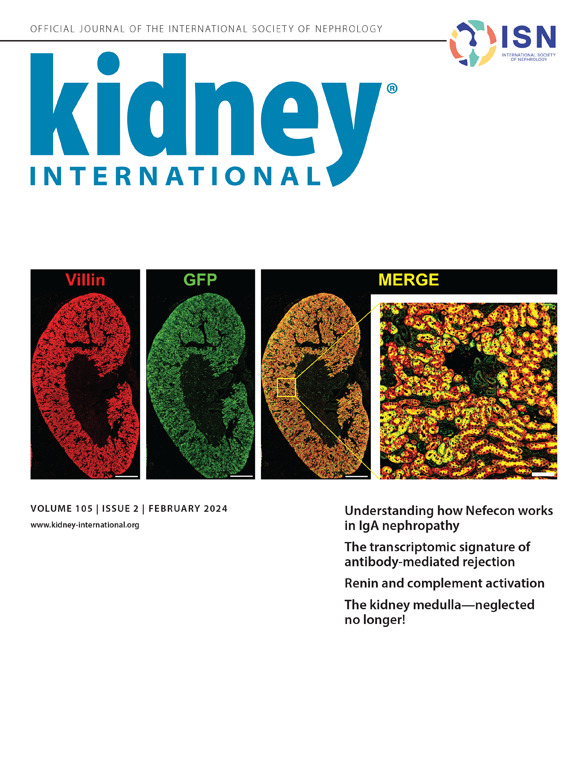Unlocking the potential of extracellular vesicles in nephrology: what does MISEV2023 add?
IF 14.8
1区 医学
Q1 UROLOGY & NEPHROLOGY
引用次数: 0
Abstract
Extracellular vesicles, small membrane-bound packages secreted by virtually all cells of the body, have become a focus of interest in nephrology over the recent years. After the first characterization of their proteomic and transcriptomic content, scientific attention shifted toward their potential as biomarkers for kidney diseases both as diagnostic and monitoring tools. More recently, researchers have begun exploring whether extracellular vesicles mediate intercellular signaling inside the nephron and between the kidney and other organs throughout the body. Nevertheless, the field of extracellular vesicle research has struggled to translate major findings to the clinical context due to numerous methods to separate extracellular vesicles, yielding fractions of different sizes and varying purity, unclear terminology, and, hence, limitations concerning reproducibility. The International Society of Extracellular Vesicles, therefore, has striven to reduce these barriers by an ongoing initiative to increase rigor and standardization of extracellular vesicle research. The “Minimal Information for Studies of Extracellular Vesicles” guideline is the result of this initiative and, in its now third iteration, provides the most concise suggestions for investigating extracellular vesicles to date. This mini review illustrates the advances made in extracellular vesicle research in nephrology so far using informative examples, outlines the advances made by the former Minimal Information for Studies of Extracellular Vesicles guidelines, and shows what potential using the latest iteration holds.
发掘细胞外囊泡在肾脏病学中的潜力--MISEV2023能带来什么?
细胞外囊泡是由人体几乎所有细胞分泌的小膜包,近年来已成为肾脏病学关注的焦点。在首次对细胞外囊泡的蛋白质组和转录组内容进行表征之后,科学界的注意力转移到了细胞外囊泡作为肾脏疾病诊断和监测工具的生物标记物的潜力上。最近,研究人员开始探索细胞外囊泡是否介导肾小球内部以及肾脏与全身其他器官之间的细胞间信号传导。然而,由于分离细胞外囊泡的方法繁多,所分离出的细胞外囊泡大小不一、纯度各异、术语不清,因此在可重复性方面存在局限性,因此细胞外囊泡研究领域一直难以将重大发现转化为临床应用。因此,国际细胞外囊泡学会一直在努力减少这些障碍,并为此持续开展活动,以提高细胞外囊泡研究的严谨性和标准化。细胞外囊泡研究的最基本信息 "MISEV-指南是这一倡议的成果,目前已是第三版,为迄今为止的细胞外囊泡研究提供了最简洁的建议。这篇微型综述通过翔实的实例说明了迄今为止肾脏病学在细胞外囊泡研究方面所取得的进展,概述了以前的 MISEV 指南所取得的进步以及最新版指南所具有的潜力。
本文章由计算机程序翻译,如有差异,请以英文原文为准。
求助全文
约1分钟内获得全文
求助全文
来源期刊

Kidney international
医学-泌尿学与肾脏学
CiteScore
23.30
自引率
3.10%
发文量
490
审稿时长
3-6 weeks
期刊介绍:
Kidney International (KI), the official journal of the International Society of Nephrology, is led by Dr. Pierre Ronco (Paris, France) and stands as one of nephrology's most cited and esteemed publications worldwide.
KI provides exceptional benefits for both readers and authors, featuring highly cited original articles, focused reviews, cutting-edge imaging techniques, and lively discussions on controversial topics.
The journal is dedicated to kidney research, serving researchers, clinical investigators, and practicing nephrologists.
 求助内容:
求助内容: 应助结果提醒方式:
应助结果提醒方式:


